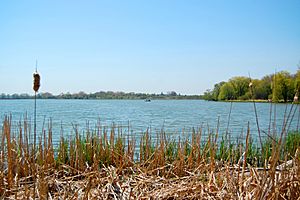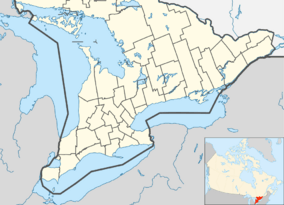Darlington Provincial Park facts for kids
Quick facts for kids Darlington Provincial Park |
|
|---|---|
|
IUCN Category II (National Park)
|
|
 |
|
| Nearest city | Courtice, Ontario |
| Area | 208 ha (510 acres) |
| Governing body | Ontario Parks |
Darlington Provincial Park is a beautiful park in the Ontario Provincial Parks system. It's located right near Highway 401, close to the town of Courtice. This park sits between the cities of Bowmanville and Oshawa.
Even though it's a smaller park, Darlington has gentle hills. These hills were formed by a "terminal moraine", which is a pile of rocks and dirt left behind by glaciers at the end of the last Ice Age. The park is right on the northern shore of Lake Ontario and also includes McLaughlin Bay. This bay is quite shallow. At one point in the 1990s, waves even closed it off completely from the lake! Next to the park, to the west, is the Canadian head office for General Motors. You can even see the Kintigh Generating Station from the park, even though it's across the lake in Somerset, New York.
Discover Park Wildlife
Darlington Provincial Park is home to many different plants and animals. Most of the plants you see are "second-generation regrowth." This means the land was cleared for farms a long time ago, and then new trees and plants grew back in the 1960s when the park was reforested.
One big challenge for the park is dealing with "invasive plant species." These are plants that aren't native to the area and can take over, harming the local plants. A big problem plant here is the purple loosestrife, which grows a lot in the marshy areas around McLaughlin Bay.
You can spot many animals in the park, from large white-tailed deer to smaller creatures like squirrels. Some people have even reported seeing coyotes and grey wolves in the park, though they are shy. Fish and amphibians also live in and around McLaughlin Bay.
Monarch Butterflies
The park is especially famous for its migrating monarch butterflies. These amazing insects travel south to Mexico as summer ends. Darlington Provincial Park is part of a bigger effort to protect monarchs. Every year, the park hosts a special event called the Monarchs and Raptors Weekend in early September. At this event, families can help tag monarch butterflies. This helps scientists track their journey and learn more about them.
Park History and Heritage
This area of Canada was settled by three loyalist families in 1794: Roger Conant, John Burk, and John Trull. They moved here because Lord Simcoe offered free land to loyalists. Samuel Burk, a descendant of John Burk, bought the land where the park is now in 1818. He lived there until he passed away in 1833. There's even a cemetery on the park property that was used by the Burk family.


